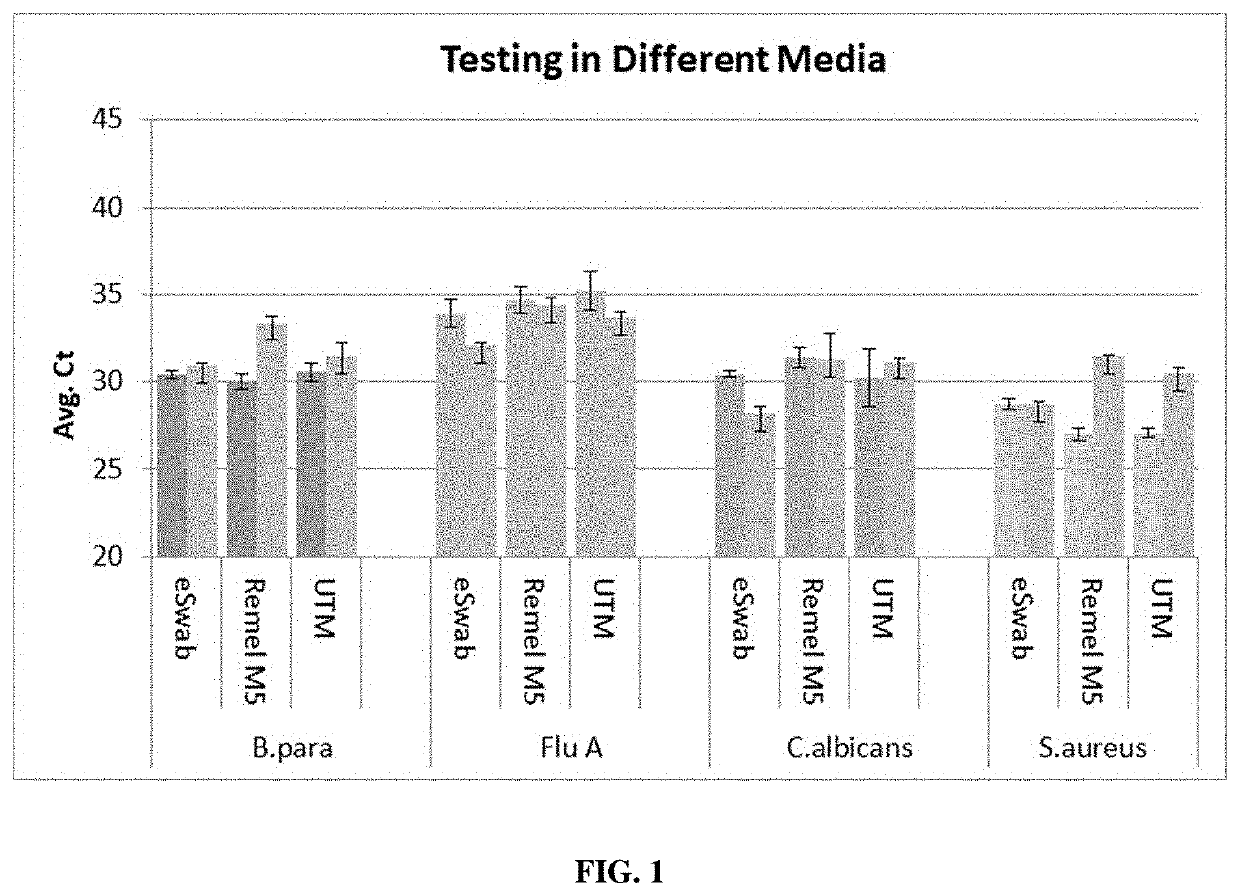Rapid cellular lysis by reduction/oxidation reaction
a cellular lysis and reduction/oxidation technology, applied in the field of molecular biology, can solve the problem of time-consuming methods
- Summary
- Abstract
- Description
- Claims
- Application Information
AI Technical Summary
Benefits of technology
Problems solved by technology
Method used
Image
Examples
example 1
is Using the <15 Minute Redox Protocol
[0042]Multiple DNA / RNA targets were assayed using a pathogen cocktail. The pathogen cocktail was comprised of RNA viruses (Flu A and Flu B), a gram-negative bacteria (Bordetella parapertussis), a gram-positive bacteria (S. aureus), and a yeast (C. albicans).
[0043]Prior to the initial redox reaction, about 30 milligrams of 100 micron silica low-binding beads were added to 100 μL of the pathogen cocktail. The redox reaction comprised adding sodium percarbonate (35 mM final concentration), proteinase K (0.04 mg), and EDTA (0.1 mM final concentration) to the pathogen cocktail. The redox reaction was incubated for about two minutes at about 60° C. The sample was heated for about one minute at about 80° C., and then sonicated for about one minute. Finally, the pathogen cocktail was diluted 1:4 in 50 mM Tris (pH 7) and added directly to an RT-PCR reaction master mix.
[0044]As a process control, pathogen cocktail was subjected to identical conditions exc...
example 2
is Using the 5 Minute Redox Protocol
[0046]Multiple DNA / RNA targets were assayed using a pathogen cocktail. The pathogen cocktail was comprised of an RNA virus (Flu A / B), a gram-negative bacteria (Bordetella parapertussis), a gram-positive bacteria (S. aureus), and a yeast (C. albicans).
[0047]Prior to the initial redox reaction, about 30 milligrams of 100 micron silica low-binding beads were added to 100 μL of the pathogen cocktail. The redox reaction comprised adding sodium percarbonate (35 mM final concentration), proteinase K (0.04 mg), and EDTA (0.1 mM final concentration) to the pathogen cocktail. The redox reaction was incubated for about two minutes at about 60° C. After the redox reaction, the sample was heated for about minute at about 80° C., and then sonicated for about 60 seconds. Finally, the pathogen cocktail was diluted 1:4 in 50 mM Tris (pH 7) and added directly to an RT-PCR reaction master mix.
[0048]As a process control, pathogen cocktail was subjected to identical c...
example 3
is of Samples in Various Media Using the 5 Minute Redox Protocol
[0050]The same experiment as described in Example 1 was performed, except that the pathogen cocktail also contained media. Three different types of media were tested to determine if they inhibited the 5 minute redox lysis protocol. The media tested were eSwab™ (Copan), MicroTest™ M5™ (Remel™, Thermo Fisher), and UTM™ (Copan). As a positive control, the samples were also analyzed using a Luminex ARIES® Benchtop system. The graph in FIG. 1 shows that none of the media inhibited the 15 minute redox lysis protocol, relative to the positive control.
PUM
| Property | Measurement | Unit |
|---|---|---|
| Temperature | aaaaa | aaaaa |
| Temperature | aaaaa | aaaaa |
| Temperature | aaaaa | aaaaa |
Abstract
Description
Claims
Application Information
 Login to View More
Login to View More - R&D
- Intellectual Property
- Life Sciences
- Materials
- Tech Scout
- Unparalleled Data Quality
- Higher Quality Content
- 60% Fewer Hallucinations
Browse by: Latest US Patents, China's latest patents, Technical Efficacy Thesaurus, Application Domain, Technology Topic, Popular Technical Reports.
© 2025 PatSnap. All rights reserved.Legal|Privacy policy|Modern Slavery Act Transparency Statement|Sitemap|About US| Contact US: help@patsnap.com

